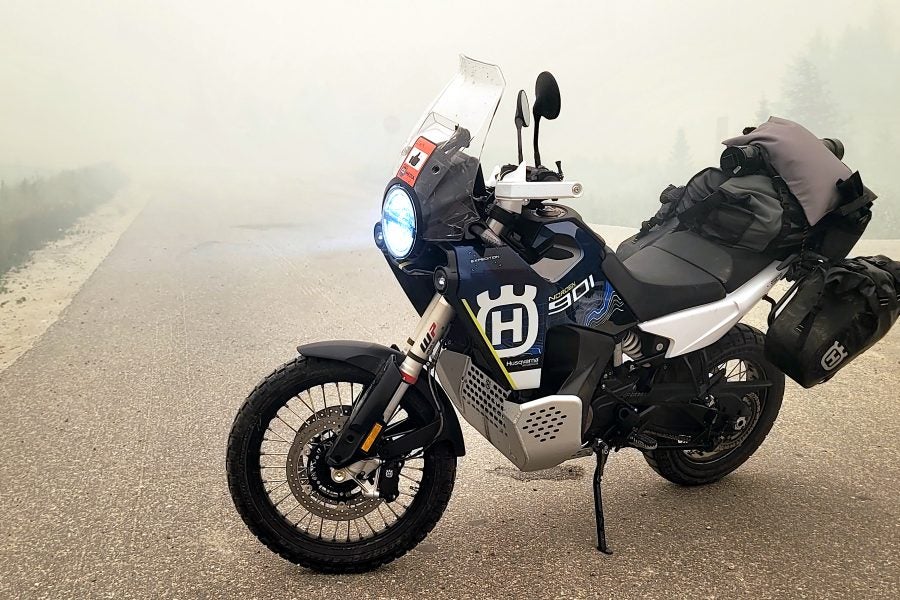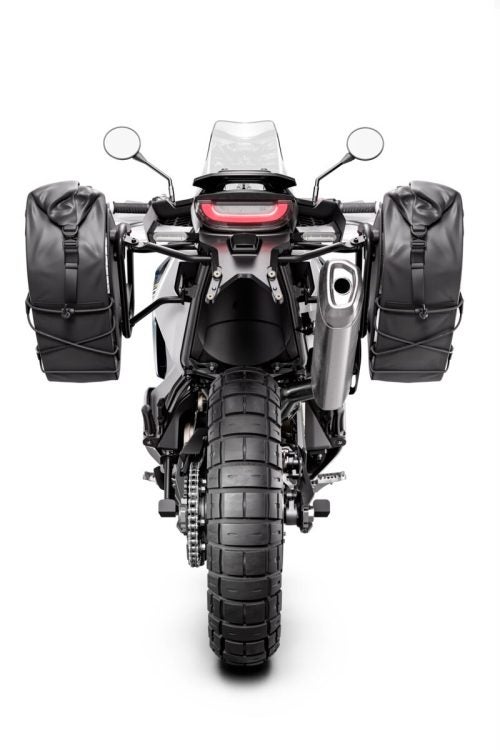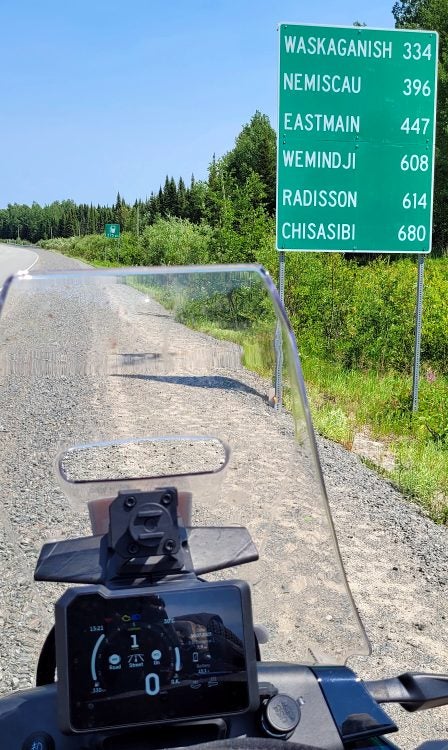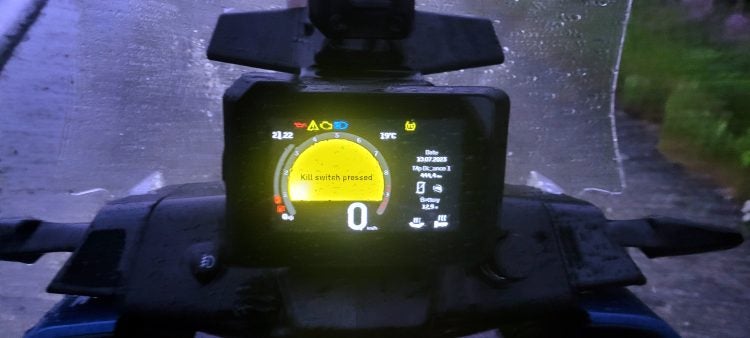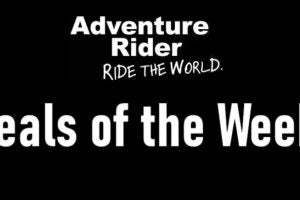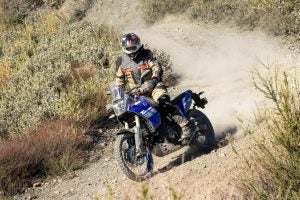Back in March, Costa Mouzouris traveled to South Africa to test the Husqvarna Norden 901 Expedition. If you want his expert review, read here. Months after that story, I planned a ride up to James Bay, in northern Quebec, via highway, back roads and gravel. I wondered: How would the Husqvarna Norden 901 Expedition work for me in the real world, away from the somewhat curated experience of a press launch, in an environment where a trip can go wrong?
As it turned out, my trip went really sideways. You can read about it in the next issue of ADVrider’s print magazine, but the short version is: My ride was cut short when I ended up on the wrong side of the forest fire—but I did put in a lot of hard and fun riding, even if I did have to turn back due to massive clouds of smoke. I came home with a much greater appreciation for this machine, because frankly, it saved my butt when things went sideways—ZK
Repurposed Parts
The Husqvarna Norden 901 Expedition officially broke cover this March with a different debut than the usual “rip the sheet off the bike at EICMA” reveal. Instead, we got a film showing Dakar hero Cyril Despres and professional adventurer (oh, how I want that job title!) Mike Horn taking the new bike on a jolly romp around Mongolia. Huzzah!

Most of the equipment on the Husqvarna Norden 901 Expedition is available for the standard model as accessories. Photo: Husqvarna
Maybe part of the reason we didn’t see a full court press on the bike’s reveal was, it was mostly stuff we’d seen before. The Expedition basically took a bunch of components that had previously existed as add-on accessories for the standard Norden (bags, luggage rack, touring screen, heated grips, heated seat) and included them as standard. The 901 Expedition also gets Explorer ride mode as standard, along with Rain, Road and Off-Road; Explorer mode, which was only optional on the standard 901, is the same as the KTM 890’s Rally mode, allowing on-the-fly adjustment of traction control interference. And like the 890 series, the relative intrusion of all electronic systems (leaning-sensitive ABS and traction control, throttle response, engine output, etc.) are all determined by which mode you’re in. Off-Road, for instance, turns off rear-wheel antilock brakes and significantly reduces interference at the front, while Rain mode eases out your power delivery. All stuff we’ve seen before, with years of R&D in the KTM lineup.
But there were also some new bits. Husqvarna put a high-rise skid plate on the bike, offering perhaps the best engine protection I’ve ever seen on a factory basher. There’s a new connectivity unit that allows riders to link their cellphone to the bike; with the Husqvarna app, this delivers turn-by-turn navigation over the TFT screen, and also allows them to control music playback and some cellphone function.
Perhaps most significantly, the standard 901 has WP Apex suspension, but the Expedition model gets WP XPLOR fork and shock, the same setup as the KTM 890 Adventure R. This adds 20 mm suspension travel fore and aft, with 240 mm of travel at fork and shock, with full adjustability, including high-compression damping adjustment in back.
However, the 901 Expedition gets softer damping rates than the 890 Adventure R. This is all part of Husqvarna’s plan to use KTM’s tech, but make the bikes… feel different. And based on a few days’ ride in my attempt to make James Bay, I think they succeeded.
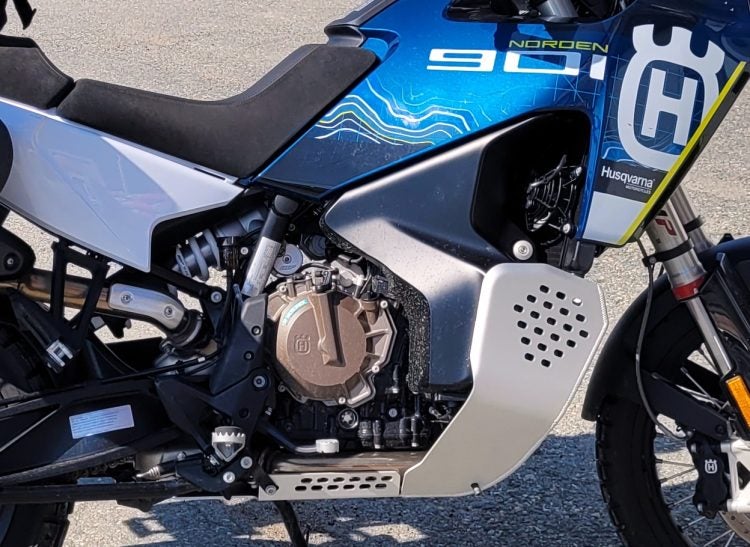
Excellent wraparound protection thanks to this massive skid plate. That seat is in its lowest position there, and I found it was OK for my 30-inch inseam, but an accessory low seat would have been nice to try. Photo: Zac Kurylyk
Loading Up
For me, a good adventure travel bike has to do several things well. It must have the power to cover long distances at high speeds in comfort, to burn boring highway miles when you’re on a tight time budget. It must be comfortable, particularly in bad weather. It should be able to haul at least a week’s worth of camping and travel equipment without seriously affecting handling. It needs to be nimble enough that an average rider can nip off the highway to check out stealth camping spots down dirt roads and trails, without worrying too much about the bike’s size. It should tear up a paved, bumpy back road with ease, and it should be completely stable and planted on forestry roads, and manageable on sandy side tracks. And it should be able to ride for at least 200 miles without stopping for fuel.
In short it should be able to hand any sort of situation with aplomb, and I think the Husqvarna Norden 901 Expedition nails all these goals.
My ride on the Norden started at the KTM Adventure Rally Canada in early July, loading up the bike’s soft panniers and strapping a Turkana Duffalo bag to the rear luggage rack (the rack is an OEM accessory, with lots of strap mount points—thanks to Husqvarna for bolting it on at my request!). Now, I travel light on trips like this, but I had zero issues loading up a tent, sleeping system, campstove, food, some assorted electronics, a fishing rod, clothes and other odds and ends, with space left over in the luggage. This was without using a tankbag or crash bar bags or anything like that. I could travel indefinitely with the gear I had on the bike, as I’m used to living like this, but if I’d needed a laptop and DSLR and another 3-4 changes of clothes, I could have fit it all easily.
- Photo: Husqvarna
- Photo: Husqvarna
This shouldn’t be surprising; this is what the 901 series was designed to do. But whether I was bombing down a bumpy backroad, riding fire roads or forestry tracks or just cruising at extra-legal speeds on the Trans Canada North, everything stayed nice and planted and didn’t adversely affect ride dynamics. At the 901 Expedition launch, some riders had issues with the stitching on the soft saddlebags, but I had no such problems, and none of the trick-looking buckles failed on me either, as I’ve seen reported. It all held up.
Maybe if I’d been truly flogging the beast off-road, I’d have a different story. But then, I’d also have a different luggage setup, something tight-to-the-bike like a rackless Giant Loop. I believe the rack-mounted soft bags are OK in the role of street touring and easy-to-moderate unpaved stuff, and if you want to truly bash around in the tough stuff, well, adjust your configuration accordingly. A closer-fitting rackless system would only make the handling even better, but as it was, I barely noticed I had a load on.
Due North
Leaving the rally, I wondered if the bike’s 19-liter fuel tank would be enough for the long stretches of Quebec’s Billy Diamond Highway, which takes you north from the town of Matagami to the towns along James Bay. I looked down at the TFT dash, and in between fiddling with display adjustments and flicking between ride modes, I noted that my remaining fuel range was increasing the longer I spent riding 80-90 km/h, or 50-55 mph. Making 350-plus kilometers (220 miles) should be no problem at all, and since the longest stretch I had between fuel stops was the legendary 381-kilometer stretch (236 miles) along the Billy Diamond Highway, I reckoned I’d be just fine.

Loaded up for a trip to northern Quebec. The 901 Expedition eats up forestry roads like this with the greatest of ease. Photo: Zac Kurylyk
I had about two hours of back roads, some of them quite twisty, before getting out to Quebec’s Route 117, the highway you must take to get from the south to the Val D’Or region, where you can then access the roads north to James Bay and beyond. While I scooted through a seemingly endless series of small towns, it became obvious the 901 Expedition would be quite the fun companion for the trip. The LC8c parallel twin (same as used in the 890 KTM series, same tuning and same 103 hp and 74 lb-ft of torque) is smooth, due to dual counter-balancers. I wouldn’t call it a soulful feel, not by a long stretch, but it has all the brap on tap that you could need for a back road. Shifting through the six-speed gearbox is slick and easy, with a slip/assist clutch, and you can just blast through the gears with the up/down quickshifter. But if you’re using the quickshifter, keep in mind that it prefers to run around the same rpm you’d normally shift at. Lugging the motor and booting the shifter up or down at low rpm is a lumpy experience, and you can’t blame the bike for that.
On to Route 117, then. Traffic was heavy, but the 901 easily parted the seas of cars and within a couple of hours I was about half-way up the highway, where the towns and their associated weekend cottage traffic disappear, replaced by a more narrow and quiet road through a series of game reserves.
Some people still religiously drive the 90 km/h speed limit here, but others take advantage of the deserted roadway to boost speeds to excessive levels. If you can find other like-minded motorists, you can convoy through here at extra-legal speeds without so much as a raised eyebrow from the traffic police. That’s what I did, and noted that even at high speed, the Husky was still fairly fuel-efficient. It easily maintained speed with a full load of luggage on, but also didn’t scream for more, more more, like some of KTM’s powerful V-twin bikes.
- You need a big gas tank up north, or good fuel economy, or both…
- … and you can get 444 kilometers (276 miles) from the 19-liter (5 USG) tank, at least, as seen here. Sorry about the terrible photo; it was the best I could do in the rain and forest fire smoke. Photo: Zac Kurylyk
It also easily shrugged off light rain showers I encountered. I was most impressed with the weather protection. The windshield is big, but flows a lot of cooling air through the middle. The tank’s plastic bodywork does an excellent job of directing air and rain around the rider’s legs. A few raindrops would make it by and hit my helmet’s screen, but it took a good long time for me to feel a trickle through my gear, and if the shower was short enough, it takes less time to dry off than it does to pull over and zip in a set of rain liners. Bonus!
This would also come in very important, later in the trip…
By the time I got far enough north that I was using gravel roads, not paved, I’d only found one real thing I didn’t like about the 901 Expedition’s road manners. The suspension is soft enough that you get quite a bit of fork dive under hard braking (the dual J. Juan stoppers have plenty of bite!). Same goes for the back end; there’s a lot of squat, under hard acceleration.
I didn’t think this was a big problem, for two reasons. First off, I think tickling the clickers on the fork and likewise tweaking the shock would help, a lot. But, I also really appreciated the bike’s much-more-accessible feel thanks to the soft suspension, when compared to the 890 KTMs. I’m happy with the trade-off.

Exploring off-the-beaten-track camping spots, like this place under a bridge, was easy with the Norden. Photo: Zac Kurylyk
I will also add that a lower accessory seat would be nice to try, but I’m not sure I would want one in the end. My 30-inch inseam was OK with the stock seat’s low position, but another inch or two lower would have been better… but might also have cramped my legs on the pegs after a few hours. These things are a trade-off.
Hitting The Dirt
With less mileage to make up once I passed Val D’Or, I started heading off-pavement at various points to either explore for stealth camping spots, or take short-cuts between communities (in particular, Quebec’s Rte 1000, which lets you bypass a lot of traffic). Switching to Off-Road mode is incredibly easy, with just a few clicks of the buttons on the left handlebar, so whether you’re going to be on a forestry road for a couple of hours or on a side road for only a couple of minutes, you can quickly reconfigure the bike to suit your new surroundings.
Because my trip was cut short, I didn’t get as much of this in as I’d hoped, and I’d recommend you read Costa’s review for a more in-depth review of the bike’s manners in the dirt. However, I will say this is a “big” adventure bike (465 lb/211 kg dry weight) that I felt had the almost the same ease of off-road use as a 650 dual sport. When push comes to shove, literally, you’ve still got a lot of weight to get un-stuck, if you’re buried up to the hubs in a sandpit or muckhole. But up until that point—the more I nipped down little goat paths, the more I wanted to try the next one, and the next one.
Obviously, being far from home and loaded down with gear greatly tempered my enthusiasm with the throttle, but at some point, I’d love to spend a few days aboard this bike much closer to home, with a buddy riding with me, so I could make riskier choices. I enjoyed this bike off-road more than any other 800-1200 cc ADV I’ve ever used.

The smoke got far worse after this point, with visibility reduced to zero percent. But, the 901 Expedition got me through it all safely. Photo: Zac Kurylyk
Safety Through Trouble
Alas, the whole trip was going nice and smooth until it wasn’t, and I had to turn back from the Billy Diamond Highway because of a forest fire (again, more on that story in the next print issue of the ADVrider mag). But in the hours of danger getting off that road, the Norden 901 Expedition shone through the bad conditions. Soaked to the skin, but in a situation where stopping to don rain gear was highly dangerous, cranking up the heated seat and heated grips to max settings kept me going. And even though I had stretched the bike’s fuel range far past most people’s comfort zone, I made it back, getting 444 kilometers (275 miles) from the stock tank before sputtering to a stop and resorting to the Giant Loop gas bag for the last 50 klicks of road.
Honestly—I think the bike would have done the full 500 kilometers, if I’d known from the start that I’d have to do so, by watching my throttle even more carefully.
In the aftermath of that disaster, I decided to come home instead of looking for adventures elsewhere in the province, as forest fires continued to pop up and I didn’t fancy straining emergency services or being stuck in a remote town for days… or losing the bike, or my life. I wasn’t out of the woods yet, figuratively or literally; it took a couple of days of hard riding to get back to KTM HQ, and I hit even more foul weather in that time (remember that rainstorm that obliterated Vermont in July? Yeah, I rode through the corner of that… ).
Through it all, the Norden kept a steady pace, comfortable for hours on end. If my butt eventually needed a break, it was easy to scoot back to the wider part of the saddle. If I was cold, it was easy to crank up the heat. If it was dark, it was easy to turn on the foglamps to spot moose or deer in the ditch.

If you’re looking for a bike that can cover big miles at fast speeds while carrying luggage, while still retaining excellent off-pavement capability, the Norden 901 Expedition is the easiest-to-ride machine I’ve ever taken for a spin yet, in the ADV travel category. Photo: Husqvarna
The Final Word
How much did I like the Husqvarna Norden 901 Expedition? On my way home, I was running spreadsheets in my head, juggling my mortgage payment and other bills, asking myself: Can I afford this bike? Should I buy it?
I’d love to. Perhaps a longer ride would have uncovered some more niggles but at this point, the only reason I don’t own this machine is the asking price ($15,799 MSRP in the US, $17,199 in Canada, before taxes and fees). Quite simply, it does everything I ask it to at least as well as the KTM 690 Enduro R travel bike I threw together last summer. It covers hard miles in bad weather with ease, and can get into and out of tight spaces off-road at the end of those long highways.
While long-term reliability is always a question mark for any new-ish product, I will note that a Norden 901 competed in this year’s Iron Butt Rally, and finished. If it can handle that 1000-miles-a-day punishment, whatever you and I can hand out to it will seem like nothing in comparison. I am sure we will hear of many more such long-distance adventures in the years to come, if my hundreds of kilometers aboard the machine are any indication of its usability as a trustworthy travel machine.


